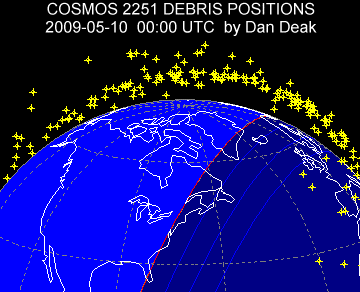Newer news: the result of this collision? A bunch of space debris was released, creating an even more hazardous environment. You can read more about this at spaceweather.com, third story down as of today (no hard links on their site!) To give you an idea of how much space junk was placed into orbit by this crash, here's a great picture from the site (click to embiggen):

All of those objects are from this single event. This is only a small percentage of the total space garbage present around Earth, whose sources range from dead satellites, satellite debris, debris from rockets and manned space flights, to naturally occurring objects such as micrometeorites. This poses two huge problems: one, where is this stuff? There are companies that do nothing but track space garbage in the sky and sell this information to space agencies. Two, where can we put a satellite without hitting this stuff, or, alternatively, is a particular satellite safe from collisions with this space trash?
While I focus on solar driven space weather on this blog, space debris is a vital part of space weather as well. Constantly tracking the innumerable bits of garbage is one more factor that goes into avoiding the hazards of near-Earth outer space.
While I focus on solar driven space weather on this blog, space debris is a vital part of space weather as well. Constantly tracking the innumerable bits of garbage is one more factor that goes into avoiding the hazards of near-Earth outer space.
No comments:
Post a Comment